Servicios Personalizados
Revista
Articulo
Links relacionados
Compartir
CLEI Electronic Journal
versión On-line ISSN 0717-5000
CLEIej vol.17 no.3 Montevideo dic. 2014
Understanding Game Playing Preferences
Cecilia M. Curlango Rosas, Jorge Eduardo Ibarra Esquer,
Gloria Etelbina Chávez Valenzuela, María Luisa González Ramírez, Linda Eugenia Arredondo Acosta
and
Marcela D. Rodríguez
Universidad Autonoma de Baja California, Facultad de Ingeniería
Mexicali, Mexico 21280
{curlango, jorge.ibarra}@uabc.edu.mx
{gloria_chavez, maria.gonzalez, linda_arredondo, marcerod}@uabc.edu.mx
Abstract
This paper presents the results of a study made with university students to determine the types of video games that they play, the platforms they use to play, and what motivates them to play or stop playing games. The study results distinguish among genders in order to be able to design appropriate teaching strategies which appeal to both genders. This work was done as part of a larger study whose aim is to both attract and retain students to the computer-engineering program.
Spanish abstract
Este artículo presenta los resultados de un estudio realizado con estudiantes universitarios para determinar el tipo de juegos de video que juegan, las plataformas que utilizan para jugar y lo que los motiva para jugar o dejar de jugar juegos. Los resultados del estudio distinguen entre géneros para poder diseñar estrategias de aprendizaje que sean atractivas para ambos géneros. Este trabajo se llevó acabo como parte de un estudio más grande cuyo objetivo es atraer y retener estudiantes en la carrera de ingeniería en computación.
Keywords: computer science education, engineering students, video game preferences
Palabras clave: educación en ciencias computacionales, estudiantes de ingeniería, preferencias de video juegos
Received 2013-11-15, Revised 2014-02-20 Accepted 2014-02-20
1 Introduction
In 2010, The United Nations Educational, Scientific and Cultural Organization (UNESCO) released a report where global challenges and opportunities for engineering were presented. The report stresses the importance of the various engineering fields in development of society, but also warns about the decreasing public awareness and understanding of engineering, and the declining interest and enrollment of young people in engineering courses [1].
This is a trend that during the first decade of the 21st Century was seen as something critical for the Computing Engineering field [2], being until recent years that some countries have started to show a slight reversal in enrollment [3]. In addition, as pointed out by De Vries et al. [4], there is also the problem of high dropout rates that reaches up to 50% in Latin American countries. In the particular case of our college, we have observed a drop in enrollment of 40% since 2006. So we are interested in analyzing the causes for this problem to design and execute quick actions that lead to an increase in interest in engineering by prospective students.
Despite the recent increase of enrollment in computer related majors that is being observed around the world, we still find it important to identify adequate strategies that allow us not only to increase the number of students that show interest in computer engineering, but also to retain those that have already started their studies and make them successfully conclude their major. There is an embedded challenge in providing learning experiences that are of significant importance and result attractive to students in order to create interest in the field and maintain that interest through their time in the university.
In this context, there are several proposals and experiences focused on facing both of the aforementioned problems. These apply not only to Computer Engineering but also to all computer related majors. In their research, published in 2009, Snyder et al. [5] list several of the situations affecting enrollment of Information Systems majors, which can also be identified in other related fields. They highlight aspects such as lack of information related to specific majors, technical difficulty of the field, salary and opportunities for professional development, among others. A main strategy for overcoming those obstacles is proposed: creating communication plans and materials that allow prospective students to obtain a clear understanding of what the specific major is about and what the real possibilities around them are. An important conclusion of this study is that for any type of strategy to actually provide expected results, active participation of faculty is imperative in both designing and executing them.
Like Synder et al. [5], Hatziapostolou et al. [6] point out some misconceptions, which they call myths, about computer sciences. Their conclusions are rather similar to those expressed in the previous work, though some important elements are stressed, such as the differences and similarities among different computer related majors, which students are not always aware of.
High dropout rates are also a matter of concern. De Vries et al. [4] analyzed the causes that lead a student to abandon his/her current major. This is an interesting work as it was conducted within a Mexican university, in a context more related to the rest of Latin American universities than most of the studies that were previously mentioned. Their results show three major factors leading to dropout: class schedule, vocation and course failure.
Correcting the class schedule problem implies collaboration among those leading the majors, faculty and students themselves, as the problem tends to grow when they have to work and their work schedule does not match with their classes. In the case of our university, people responsible for creating schedules are encouraged to arrange classes in blocks that allow students to perform external activities without problems.
Vocation is an important aspect, closely related to the communication strategies that were pointed out in other research. De Vries et al. [4], found that around 40% of dropouts occur because students were not fully aware of what the major they had chosen was about, realized that it was not the appropriate profile for them and decided to switch majors.
The case for course failure has been widely studied. We have further observed that when this failure happens in introductory courses, it eases the decision for the student to leave his current major and try to finish his studies in a different field. In our specific case, when students first enroll in a common core of engineering courses, we have found a problematic course in Introductory Programming [7]. High failure rates for this course not only affect dropout rates, but also enrollment into Computer Engineering, as students find the course rather difficult or lacking a real sense of application, and tend to choose a different area to major in.
Beaubouef and Mason [8] identified several reasons for a high dropout rate in computer science students, such as a lack of preparation in logic and math, improper teacher-student communication, poorly designed laboratory courses, not enough practice, not enough feedback from instructors, inexperienced teachers, poor student time management skills, and inappropriate choice of programming language for introductory programming classes.
There are several examples of strategies oriented to modify introductory programming courses, trying to improve enrollment and retention of students. Carver et al. [9] found positive results when using peer programming; Rubin [10] discusses the benefits of live coding within the classroom; Leutenegger and Edgington [11] point out the benefits of using games for teaching introductory programming concepts.
Using video games is an interesting strategy as it is based on the learning models and motivational aspects that new generations of students have. Oblinger [12] states that using games results in a powerful learning tool, which allows development of several skills, while also being attractive for young students of college age who possess a wide experience in different types of games.
Taking these concepts as a start, we decided to explore the use of video games as part of the Introductory Programming course. The first stage of this project, as described in this paper, consisted of a study conducted among our current students, oriented to identifying the characteristics of the video games that are more interesting and alluring for them, with the objective of using this information for making specific and appropriate strategy design and implementation decisions.
The remainder of this paper has the following structure; we begin by exploring some of the findings reported as to the differences among genders regarding video game playing preferences. Then we describe in some detail the experiences of other academics in the use of video games as a tool for teaching computer science concepts. Then we describe the methodology we followed to obtain data regarding the type of games that current students play and their motivation both for playing and for no longer playing a video game. After this we present some of the results of our study and conclude with the insights we obtained from it and outline how these results will be used in our future work.
2 Related work
There have been multiple studies regarding video game playing preferences among genders. Jeong [13] analyzed the amount of violence found in the narrative of computer games proposed by male and female high school students in Korea. He found that the male students’ narratives had more aggression and violence than the female students’ narratives. He also collected data regarding these students game playing frequency and found that males showed a higher game playing frequency and that they played more games depicting violence than females did. The results indicate that students have a greater exposure to violent and aggressive environments in the games that they play regularly and that males have a greater exposure than females do. This exposure was in turn reflected in the games that they created through their narratives.
However, gender alone is not a sufficient predictor of game playing habits as indicated by Carr [14]. She found that gaming preferences are alterable and depend on location. These findings were also reflected in a study by Armory and Molomo [15] who found that among young South Africans who did not have a substantial exposure to video games, there was a marked preference among both males and females for nonviolent games over violent ones. Indeed both genders indicated that their preferred games were Need for Speed and Tiger Woods.
Awareness of gender differences is important since they have implications for video game development. Kimura [16] found biological sex differences among males and females. For instance, males are better than females at tasks such as mental rotation of three-dimensional objects, navigation through mazes, and hitting targets. Females, on the other hand, are more skilled at remembering objects they see on a route, noticing when an object has moved, and matching items. It has been found however, that these differences can be modified and diminished. Feng et al. [17] found that playing action video games decreased the difference in spatial attention as well as the difference in mental rotation ability between genders. Spatial abilities have been associated with success in mathematics and science courses [18] and with the choice of mathematics and science as majors in college [19]. Thus playing action video games may have the added benefit of aiding engineering students as they take math and science courses which in turn could reduce the high dropout rates that they display during their first semesters.
Some computer science programs in different universities have explored integrating game development into their curriculum as a way to attract new students. As described by Leutenegger and Edgington [11], the University of Denver used a Games First approach to teaching introductory computer science in an effort to address a 60-70% reduction in first year enrollment in computer science majors. Their approach consisted of changing the content of their first three introductory programming courses. They began by introducing programming using Flash and ActionScript thus providing instant visual feedback to students as they developed their applications. The second course taught C++ and the Unix operating system, while the third course, also in C++, introduced students to graphics programming using OpenGL. This approach, they maintain, lends itself to attracting women to computer science since as anecdotal evidence shows, they are more attracted to casual games.
Another approach, also game-based, is described by Claypool and Claypool [20]. In this instance, a Software Engineering course is taught based on video game development. The course is divided into the following modules: introduction, development life cycles, project and team management, requirement elicitation, introduction to game design, requirement analysis, system design, object design, implementation and testing. An analysis of course enrollment showed that there was an increase from 7 students when the course was taught in the traditional manner to 22 students when it was taught in a game-centric manner. They found that game development lends itself to richly illustrating all the aspects of the software development life cycles and that it is also motivating to students, thus, making classes more effective since it focuses students attention on something which is of interest to them.
Garcia et al., researchers from Universidad Complutense de Madrid describe their experiences in attracting new generations of students to computer science in [21]. They apply students’ knowledge of algorithms and data structures as well as design patterns and mobile device programming to game development in Java using a game of Sudoku as an application. Students found this approach to be a fun and interesting way to apply the knowledge they had obtained in the more theoretical courses.
As Barnes et al. describe [22], a game-centric approach has also been used to teach basic computer science concepts. In this case the project had the objective of retaining current computer science students as well as recruiting new students particularly women and minorities. The project leveraged students’ enthusiasm for social games and focused on having advanced students create games that could be used to teach introductory topics in computer science to less experienced students.
There are several instances of using games to teach various topics in computer science. Becker [23] reported that students were better able to understanding object inheritance by programming Minesweeper and Asteroids. Using games to teach introductory computer science, Bayliss and Strout [24] found that students felt less intimidated by their classmates and their performance increased. The Alice program developed at Carnegie Mellon University is used to tell stories and has been reported [25] to foster higher retention rates compared to students who programmed using a more traditional language like C++. Scratch, developed at the Massachusetts Institute of Technology by the Lifelong Kindergarten Group is a program that teaches programming within a visual learning environment. In a study by Maloney et al [26], in which they queried 30 random students regarding their use of the Scratch environment, the researchers found that the students did not realize that they were programming when they were using Scratch.
From the literature we can conclude that a game-centered approach has been used successfully to recruit and retain students in computer science programs since students find it motivating to work on topics that are of interest to them. What is not clear from the literature is the type of game that is most appropriate nor is the difference between females and males in terms of games addressed.
3 Methodology
Figure 1 presents the methodology we are following for developing game-based prototypes that enables us to evaluate our approach for attracting students to the Computer Engineering program. This methodology is based on user-centric methods, which will allow us to design prototypes that match the students gaming preferences, resulting in learning objects that are easy to use for programming courses [27]. During the first stage we got an initial understanding of this problem domain by reviewing relevant literature. Afterwards, we carried out a case study in order to identify how the students gaming preferences may impact on the design implications of game-based learning objects. The aim of the design stage is to identify some usage scenarios for representing the users’ (students and professors) interactions with a particular envisioned prototype, and then, design the user interfaces, the game flow and functionality. As presented in Figure 1, the methodology is iterative, since we plan to evaluate the usability of the prototypes’ designs, which may require redesigning them before implementing them. Similarly, the implemented prototypes may require being evaluated, which may lead us to make new design decisions for improving the prototypes’ usability. Finally, when we obtain robust prototypes, we plan to evaluate our approach through in-situ evaluations (i.e. they will be used as learning objects in introductory programming courses).

Figure 1: Methodology based on the User-Centered Approach; a) Stages already carried out; b) Stages to achieve
3.1 Case study protocol
We carried out a case study with the aim to identify the gaming preferences of undergraduate students. This was a focus group session, which is a qualitative research tool used to explore people’s meanings, ways of understanding, or experiences of a complex phenomenon [28]. That is, it is a methodology that enables a researcher to get to know a target audience in detail, i.e. to get a clearer view on the reason for a behavior [28], such as understanding the gamer’s experience [29]. It typically involves a series of group interviews about a given topic or phenomenon guided by a moderator.
The criteria for recruiting participants were the following:
• Select up to 30 students of the Computer Engineering program of our University campus.
• Select students that like to play any digital games, such as those designed for computers, consoles, mobile devices or Internet.
• Balancing the number between male and female participants.
The focus group session consisted of two activities. The first one had the aim to identify the preferred games that students play. To achieve this, we provided each participant with a set of post-it notes and a poster board, which were used to annotate and organize their responses to the 5 questions shown in Figure 2a). One of us, playing the role of moderator, asked each question, provided students with time to discuss it (if necessary with other students) and then, requested each of them to write their answer on the corresponding post-it note. As a result, we obtained from each participant a board with a list of their favorite games prioritized by high (board top) to low (board bottom) playing frequency. For answering the questions, participants used post-it notes of different colors to indicate their responses as shown in Figure2a and b). Thus, from each game (written on a yellow post-it), students indicated the playing consoles or platforms (on a pink post-it note) that they use for playing each game and the modality they used to play (on-line or off-line); and finally, they included the motivation for playing (blue post-it note).
An the end of the session, we interviewed students to collect information regarding the factors that influence their decision:
1. to acquire or start to play a new digital game,
2. to definitely stop using a particular digital game;
And once they acquire a digital game, what factors influence on their decision:
3. to select a digital game for playing in that particular moment,
4. to stop playing this digital game.
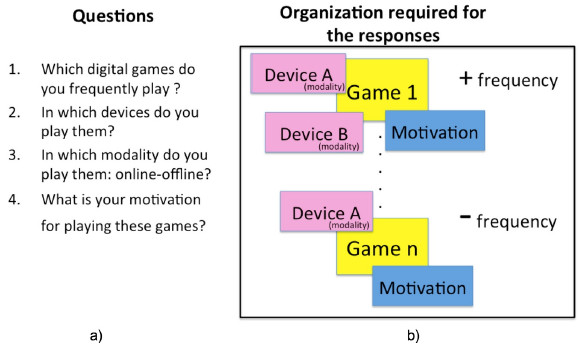
Figure 2: Design activities for gathering data during the focus session; a) Questions asked during the session;
b) Poster board design for organizing the answers to the questions
4 Results
A total of 30 students participated in the focus group session, equally divided among females and males. To analyze the results of the study we began by determining the playing platforms that students use when playing digital games. Table 1 shows these results separated by gender as well as the total participants that use each type of platform. The top platform is the PC, all participants, except one male, reported playing at least one game on this platform. The next platform is Playstation in which we included several types Playstation 2, Playstation 3 and Playstation Personal. A total of 16 participants reported using this platform, evenly divided among the genders. The third platform was tied between Nintendo and Xbox 360 each reportedly used by 11 participants. The Nintendo platform category includes Nintendo, Nintendo 64 and Nintendo DS. The fourth platform was also a tie; they include Gamecube and Wii with 9 participants reportedly using these for playing. The remaining platforms were cellular telephone used by 7 participants, Gameboy used by 4 participants and Dreamcast and iPod used by one participant each.
Classifying video game by genres is a subjective process [30]. Indeed there are multiple genres and some genres are actually combinations of other genres. A partial list of genres is found in [31]. To identify the game genres preferred by participants, a list of all the games was obtained. This list was then ordered by game and then each game’s genre was identified based on its classification as reported on various Web sites dedicated to video games. Three expert gamers then validated the genres. The results as shown in Table 2 demonstrate that the top game genre that participants play is the First Person Shooter with 17 participants reporting playing this genre of game. The next genre was a tie between Fighting and Puzzle played by 15 participants. In these two genres there was a marked difference among the genders with males (12) preferring fighting games in a greater number than females (3). In contrast, the Puzzle genre was preferred more by females (11) than males (4). The next genre, also a tie, was Role Playing and Strategy played by 14 participants each. In this instance the differences between the genders was not as marked. In the Role Playing genre, males (9) were in the majority as compared to females (5). In the Strategy genre females (8) were in the majority as compared to males (6) however the difference was slight between the two. In the next genre Action, preferred by 12 participants, males (9) preferred it in greater number than females (3). In contrast, the Simulation genre, preferred by 11 participants, was most preferred by females (9) than males (2). The Survival/Horror genre was preferred by 10 participants equally divided among genders. The remaining genres listed in 2 also exhibit a marked difference in preference by gender.
Table 1: Game playing platforms students use to play digital games
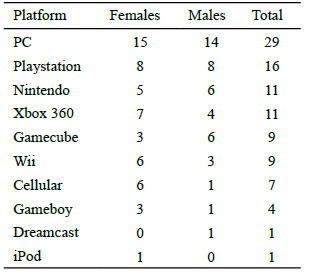
Participants as a group reported playing 96 different games. This total does not include different versions of the same game, for example Age of Empires and Age of Empires 2 were counted as one game. Some games were reportedly played by only one participant or two. Given the large number of games and the small number of participants that played some of these, we only list in Table 3 the top games that participants play. In deciding which games to include in this list, we considered those that were played by at least 5 participants with the same gender. There was a tie for the most popular game. The first of these, played by 11 participants, was Angry Birds. This game was overwhelmingly played by females (10). The other top game in terms of popularity was Tetris. In this instance, it was also favored by a greater number of females (7) than males (4). In second place with 10 participants reportedly playing it, was the game The Legend of Zelda, this game was preferred more by males (7) than females (3). Third place was also tied between two games. The first, Resident Evil played by 9 participants with females (6) showing a greater preference for it than males (3). The second was, Super Smash Bros. played by 9 participants, with males (7) preferring it more than females (2). Fourth place was also tied with 8 participants playing each game. Interestingly, only females reported playing these games. Fifth and sixth places were also tied with 7 and 6 participants respectively. Again preference for these games was segregated by gender.
In this section we now report the results of the answers provided by participants as to their motivation for initiating game playing and for terminating game playing. These results were obtained from the responses provided by participants during the second part of the study. To obtain the categories shown in the tables that followed, first two researchers independently reviewed participants’ responses and decided what category each response or part of a response corresponded too. Then in order to resolve differences, the two researchers met and discussed discrepancies in categorization. As a result of this discussion, some responses were recategorized while others stayed the same.
The first question posed to participants was How do you decide which game to buy or play for the first time ever? and the categories that their responses fall into are shown in Table 4. These results show that there is a difference between the criteria that females use to acquire a game and that used by males. The majority of females (10) indicated that they base their decision on recommendations of friends and other people they know, while only 5 males indicated basing their selection on the recommendations of friends and other people they know. Males were more apt to rely on game reviews found on the Web and in gaming magazines with 8 of them expressing this preference. Only 5 of the females indicated relying on reviews.
In addition, males were more likely to select a game based on the game’s theme; 6 males expressed basing their decision on a game’s theme while only 4 females based their decision on the theme. Watching a game’s trailer was also one of the criteria used to select a game; 4 females and 3 males reported using this criterion. A game’s graphics were also reported as being a factor considered by 3 females and 3 males. Only one female indicated that a game’s music motivated her to acquire a game. Two males and no females indicated that a game’s attractiveness was a factor. One male indicated that he acquired a game based on the platform it was available for. Also, one male reported basing his decision on the price of the game and another on the game maker’s reputation.
Other factors were also reported to influence an acquisition but by fewer participants. Only 3 females and no males reported selecting a game after having tried it out themselves. Similarly, 3 females and no males indicated that they acquired games after watching someone else playing it. An equal number of males (2) and females (2) indicated that a game’s playability or difficulty helped them with their decision to acquire
Table 2: Genre of games participants play
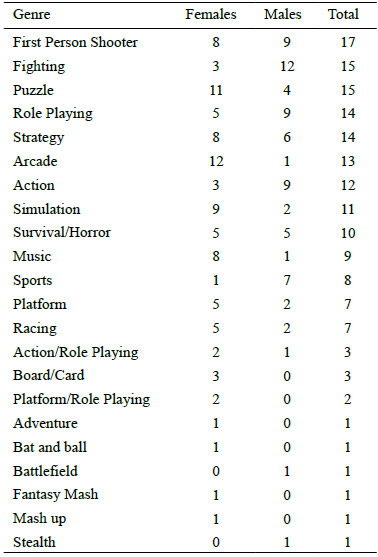
Table 3: Games participants play
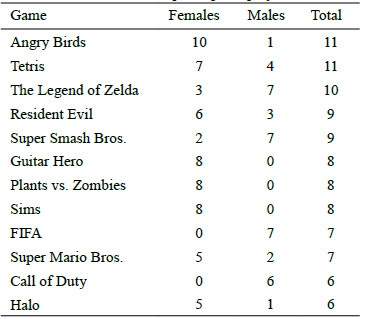
Table 4: Considerations for Acquiring or Playing a New Game
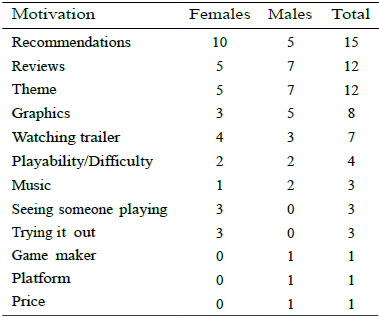
Table 5: Considerations for Permanently Abandoning a Game
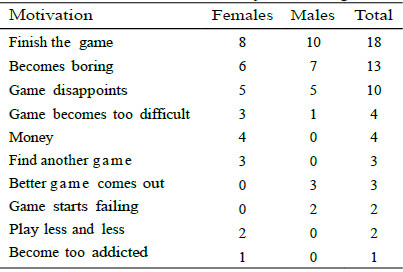
The second question posed to participants during the interview session was How do you decide to permanently stop playing a game? and participants were encouraged to list all the factors that influenced their decision. Their responses are shown in Table 5. In this case there were also differences among the responses give by female and male participants. Males listed fewer reasons than females. However, there were some similarities in the top three responses given by both genders. The top reported reason, given by 8 females and 10 males, for no longer playing a game was that they had finished the game, that is they had finished all the game’s levels or unlocked all the features that could be unlocked. The second top reason, given by 6 females and 7 males for abandoning a game forever, was because it becomes boring. The third reason given for abandoning a game was that they were disappointed by the game, this was the reason given by 5 females and 5 males. A game could also be abandoned if it became too difficult, according to 3 females and 1 male. Running out of money was the reason that 4 females indicated caused them to stop playing a game. This reference was made to games, which required paying for a membership or subscription. Three females indicated that they stop playing a game when they find another they like. In contrast 3 males indicated that they stop playing a game when a better one comes out. Two males reported playing a game until it starts failing, that is until the disk or cartridge becomes damaged. Two females indicated that they just started playing a game less and less until they finally abandoned it. One participant indicated that she stopped playing a game when she felt she had become too addicted to it.
Table 6: Considerations for choosing game to play
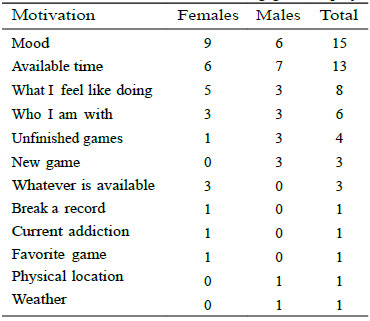
The third question participants answered was How do you decide to start playing a game? in order to gauge their motivation once they had acquired a game. Their answers are shown in Table 6. But we will discuss the top reason they gave. The top answer, given by 9 females and 6 males was that it depends on the mood they are in. Some of the comments in this respect were it depends on my mood, if I am angry I prefer fighting games and depending on how I feel, sometimes I feel like shooting. The next reason given by 6 females and 7 males was that they selected which game to play based on the time they had available to play. The third answer given by 5 females and 3 males was they selected a game based on what they felt like doing. A fourth answer given by an equal number of females and males (3) was that they selected a game based on whom they were with at the moment. Another criteria was choosing the games that they had not as yet finished, this was mentioned by 1 female and 3 males. Other reasons given exclusively by female participants were: whatever is available (3), my current addiction (1), my favorite game (1) and the one where I will break the record (1). Similarly only males gave some answers, such as: a new game (3), the weather (1), and physical location (1).
The fourth question posed to participants was How do you decide to stop playing the game you are currently using?. The answers participants gave are shown in Table 7. The top reason given by both females (11) and males (11) for deciding to stop playing a game was that it was time to do something else. The responses that were included in this category did not include those that mentioned that it was time to sleep. Becoming bored with the game was another reason for stopping given by 3 females and 5 males. Interestingly only females (7) indicated that they stopped playing due to feeling pain either in their head, eyes or fingers. As a separate category we considered the responses given by 5 females and 1 male mentioning that they stopped playing because it was time to go to sleep. Other reasons for stopping given by 4 females and 1 male was that the game they were playing had become too difficult, or that they felt they had been playing too long (3 females and 1 male). Feeling tired was the reason given by 1 female and 2 males. Reaching a new phase or level in a game was the moment in which 1 female and 1 male stopped playing. Finally, the reasons given by single participants for stopping game play were: when it was another player’s turn, when a membership or subscription had expired, and when a non-playing visitor arrived.
5 Conclusions and Future Work
The use of video games to teach different aspects of computer science and programming has been used in a variety of universities around the world. In order for students to be more receptive to learning, the development of projects with ludic activities has been proposed. This study identified students’ preferences regarding the video games that interest them and their motivation for using them. There is no clear preference among male and female students for a particular game. Males tend to select games that involve fighting, where there is a role and shooting involved. Among females, the tendency when choosing a game is towards arcade type games, puzzles and those that involve shooting. Thus among genders, the common characteristic for game preferences are those that involve shooting. Specifically the study helped identify that the genre most preferred by both genders is first person shooters. In addition, it also indicated that the personal computer is the platform that both genders overwhelmingly prefer for playing video games.
Table 7: Considerations for stopping play.
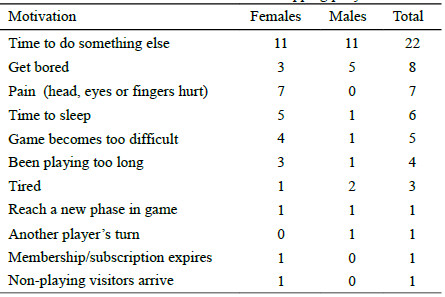
Diverse motivating factors for acquiring a new game were also identified. The main ones mentioned were recommendations from friends or persons they know, reviews from specialized web sites or magazines, and a video game’s theme.
This study also indicated that participants responsibly organize and identify when they need to spend time performing other activities besides playing, since the main motive for deciding to temporarily stop playing a game was that they had something else to do. The motivation for permanently not playing a game was that they become bored with it or that it disappointed them.
The information from this study identifies a clear direction for future work. To help ensure a successful implementation of a game-centered approach, the games that are the main focus of courses should involve shooting and belong to the first person shooter genre. Thus we visualize creating an environment in which students who are taking basic programming courses will be provided with a first person shooter game and are able to modify it as part of their learning experience. This will provide them with the opportunity to learn by modifying an application that suits their preferences. By taking this approach where students are not required to create a new game but rather work to modify or enhance an existing one, we hope to avoid the problems associated with design that Hayes [32] points out in her review of software and strategies as they relate to games. Instead, we aim to provide the type of environment that Hayes says will motivate students to transition from games to learning programming.
Acknowledgment
The authors’ work was made possible by the facilities provided by the School of Engineering of Universidad
Autonoma de Baja California.
References
[1] UNESCO, “Engineering: Issues challenges and opportunities for development.”
[2] T. L. Lenox, C. R. Woratschek, and G. A. Davis, “Exploring declining CS/IS/IT enrollments,” Information Systems Education Journal, vol. 6, no. 44, pp. 1–11, 2008.
[3] S. Zweben, “Undergraduate CS degree production rises; doctoral production steady: 2009-2010 Taulbee Survey,” Computing Research News, vol. 23, no. 3, pp. 6–21, 2011.
[4] W. De Vries, P. Leon Arenas, J. F. Romero Mun˜oz, and I. Hernandez Saldan˜a, “¿Desertores o decepcionados? Distintas causas para abandonar los estudios universitarios,” Revista de la educaci´on superior, vol. 40, no. 160, pp. 29–49, 2011.
[5] J. Snyder, G. J. Slauson, and D. Carpenter, “An action plan to increase IS enrollment based on recent survey evidence,” Information Systems Education Journal, vol. 7, p. 65, 2009.
[6] T. Hatziapostolou, A. Sotiriadou, and P. Kefalas, “Promoting computer science programmes to potential students: 10 myths for computer science,” Proceedings of the 3rd Informatics Education Europe, 2008.
[7] C. Curlango-Rosas, J. E. Ibarra-Esquer, M. L. Gonzalez-Ram´ırez, L. E. Arredondo-Acosta, and G. E. Chavez-Valenzuela, “Faculty collaboration in the evaluation of new technology for teaching computer science,” in World Conference on Educational Multimedia, Hypermedia and Telecommunications, vol. 2012, no. 1, 2012, pp. 573–580.
[8] T. Beaubouef and J. Mason, “Why the high attrition rate for computer science students: some thoughts and observations,” ACM SIGCSE Bulletin, vol. 37, no. 2, pp. 103–106, 2005.
[9] J. C. Carver, L. Henderson, L. He, J. Hodges, and D. Reese, “Increased retention of early computer science and software engineering students using pair programming,” in Software Engineering Education & Training, 2007. CSEET’07. 20th Conference on. IEEE, 2007, pp. 115–122.
[10] M. J. Rubin, “The effectiveness of live-coding to teach introductory programming,” in Proceeding of the 44th ACM technical symposium on Computer science education. ACM, 2013, pp. 651–656.
[11] S. Leutenegger and J. Edgington, “A games first approach to teaching introductory programming,” in ACM SIGCSE Bulletin, vol. 39, no. 1. ACM, 2007, pp. 115–118.
[12] D. G. Oblinger, “The next generation of educational engagement,” Journal of interactive media in education, vol. 2004, no. 1, 2004.
[13] C. H. Jeong, “Gender differences in student-created game narratives based on ESRB ratings,” in Proceedings of World Conference on Educational Multimedia, Hypermedia and Telecommunications 2011, T. Bastiaens and M. Ebner, Eds. Lisbon, Portugal: AACE, June 2011, pp. 3470–3476.
[14] D. Carr, “Contexts, gaming pleasures, and gendered preferences,” Simulation & Gaming, vol. 36, no. 4, pp. 464–482, 2005.
[15] A. Amory and B. Molomo, “Gendered play and evaluation of computer video games by young south africans,” Gender, Technology and Development, vol. 16, no. 2, pp. 177–196, 2012.
[16] D. Kimura, Sex and cognition. The MIT Press, 2000.
[17] J. Feng, I. Spence, and J. Pratt, “Playing an action video game reduces gender differences in spatial cognition,” Psychological science, vol. 18, no. 10, pp. 850–855, 2007.
[18] A. R. Delgado and G. Prieto, “Cognitive mediators and sex-related differences in mathematics,” Intelligence, vol. 32, no. 1, pp. 25–32, 2004.
[19] M. B. Casey, R. Nuttall, E. Pezaris, and C. P. Benbow, “The influence of spatial ability on gender differences in mathematics college entrance test scores across diverse samples.” Developmental Psychology, vol. 31, no. 4, p. 697, 1995.
[20] K. Claypool and M. Claypool, “Teaching software engineering through game design,” ACM SIGCSE Bulletin, vol. 37, no. 3, pp. 123–127, 2005.
[21] J. A. R. Garc´ıa, B. F. Manjon, and M. A. G. Mart´ın, “Aprendizaje de t´ecnicas avanzadas de programación orientada a objetos mediante programaci´on de juegos,” Actas de las XII Jornadas de Ensen˜anza Universitaria de la Inform´atica (JENUI 2006), pp. 387–394, 2006.
[22] T. Barnes, H. Richter, E. Powell, A. Chaffin, and A. Godwin, “Game2learn: building CS1 learning games for retention,” in ACM SIGCSE Bulletin, vol. 39, no. 3. ACM, 2007, pp. 121–125.
[23] K. Becker, “Teaching with games: The minesweeper and asteroids experience,” J. Comput. Sci. Coll., vol. 17, no. 2, pp. 23–33, Dec. 2001.
[24] J. D. Bayliss and S. Strout, “Games as a ”flavor” of CS1,” in Proceedings of the 37th SIGCSE Technical Symposium on Computer Science Education, ser. SIGCSE ’06. New York, NY, USA: ACM, 2006, pp. 500–504.
[25] P. Mullins, D. Whitfield, and M. Conlon, “Using Alice 2.0 as a first language,” Journal of Computing Sciences in Colleges, vol. 24, no. 3, pp. 136–143, 2009.
[26] J. H. Maloney, K. Peppler, Y. Kafai, M. Resnick, and N. Rusk, “Programming by choice: Urban youth learning programming with scratch,” SIGCSE Bull., vol. 40, no. 1, pp. 367–371, Mar. 2008. [Online]. Available: http://doi.acm.org/10.1145/1352322.1352260 [27] D. Norman, “The design of everyday things (originally published: The psychology of everyday things),” 1988.
[28] P. Lunt and S. Livingstone, “Rethinking the focus group in media and communications research,” Journal of communication, vol. 46, no. 2, pp. 79–98, 1996.
[29] K. Poels, Y. de Kort, and W. Ijsselsteijn, “It is always a lot of fun!: Exploring dimensions of digital game experience using focus group methodology,” in Proceedings of the 2007 conference on Future Play, ser. Future Play ’07. New York, NY, USA: ACM, 2007, pp. 83–89. [Online]. Available: http://doi.acm.org/10.1145/1328202.1328218
[30] P. Vorderer and J. Bryant, Playing Video Games: Motives, Responses, and Consequences (Lea’s Communication Series). Hillsdale, NJ, USA: L. Erlbaum Associates Inc., 2006.
[31] D. Pinelle, N. Wong, and T. Stach, “Using genres to customize usability evaluations of video games,” in Proceedings of the 2008 Conference on Future Play: Research, Play, Share, ser. Future Play ’08. New York, NY, USA: ACM, 2008, pp. 129–136.
[32] E. R. Hayes and I. A. Games, “Making computer games and design thinking a review of current software and strategies,” Games and Culture, vol. 3, no. 3-4, pp. 309–332, 2008.














